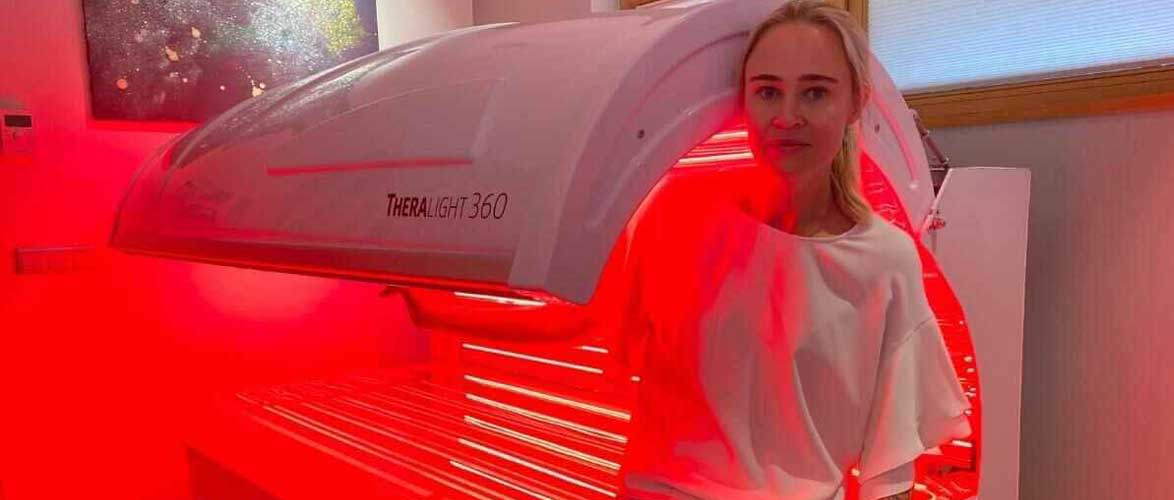5 Benefits of Near-Infrared Light Therapy
The human body experiences benefit from certain types of light therapy, including red and near-infrared light. What is the difference between the two? Near-infrared (NIR) light therapy uses light in the 800 to 1000nm wavelength range, just outside the visible spectrum of light. Red light therapy, however, is found within the visible light spectrum. Nonetheless, these two forms of light therapy are often grouped into red and near-infrared light therapy. This blog will cover the benefits of NIR therapy on the body and compare it to red light therapy.
1. Skincare Benefits
Light in this range stimulates cellular energy that encourages the skin to renew and heal, which helps improve the skin’s look, feel, and texture. NIR light enables the skin to recover from injury, discussed more below. It also provides anti-aging benefits for the skin. This light wavelength improves levels of collagen and elastin, which are partly responsible for youthful-looking skin. Near-infrared light therapy works against skin aging issues that might be bothering you, such as wrinkles and sagging, and promotes elasticity, smoothness, and good texture.
2. Anti-Inflammatory Processes
Continuous inflammation is one of the problems caused by too much oxidative stress. While some inflammation has a healing purpose in the body, too much contributes to health problems. NIR therapy provides cellular energy and blood vessel widening that help to counteract inflammatory responses within the body. This therapy cuts down on inflammation, but it also helps your body heal tissue damaged by inflammation.
3. Injury Recovery
NIR promotes injury healing, both through its skin benefits and beyond. It encourages the healing of skin tissue injuries, as the increased collagen production helps wounds heal faster and minimizes scarring. In addition, this light therapy goes farther than skin deep to help your body’s natural healing process when you have acute injuries, sore muscles, joint and muscle pain, minor muscle damage, or repetitive injuries.
You can use this light therapy directly on an injured spot or within a full-body treatment. By working with the body’s natural healing processes, including inflammation and circulation, light therapy supports healing even better than ice, which slows the initial, beneficial inflammation and, therefore, may delay healing.
4. Full-Body Photobiomodulation Benefits
Photobiomodulation therapy is another term for light therapy that expresses how healing light promotes positive life-changing processes. While you can use near-infrared light therapy to target a specific area, such as the face or an injured spot, it’s especially beneficial for a full-body photobiomodulation treatment. Using a light therapy bed exposes your entire body to the benefits of this therapy and helps promote cellular function throughout the body, both on a superficial skin level and deep within the body.
5. Customized Treatment
Light therapy provides the ability to adjust to the goals and needs of each patient. There are light therapy treatment options to provide the most benefit. In addition to choosing the light wavelength, such as near-infrared light, a light therapy provider can also choose continuous-wave treatments that offer a reduced power, ongoing session, or pulsed wave treatments that provide quick bursts of higher energy. In addition, a provider can give therapy for a certain length of time during each session and can recommend a treatment frequency and duration to fit your care plan, whether your goal is to improve wellness, create better-looking skin, or heal an injury.
How Does NIR Light Compare to Red Light?
Near-infrared light is outside the visible light spectrum, while red light falls within the range with wavelengths between 600 and 700nm. Red and near-infrared light therapies are often grouped, especially in comparison to other types of light therapy, such as blue light or green light.
Photobiomodulation therapy often uses wavelengths within red and near-infrared light because they both provide healing benefits to the body. Typical wavelengths used for healing include red light of 635nm and near-infrared light of 810nm, 850nm, and 980nm. These light therapy wavelengths work so well with people because they are absorbed by water, and our bodies are made up of such a high percentage of water.
Learn More About NIR Therapy
Overall, near-infrared and red light therapy can benefit the human body by positively impacting cellular processes. Consult with a healthcare professional on whether near-infrared light therapy could be a good fit for your health goals, or seek a red light therapy provider for customized treatment to fit your needs.

